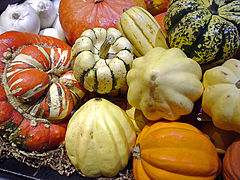Winter squash

Winter squash is an annual fruit representing several squash species within the genus Cucurbita. Late-growing, less symmetrical, odd-shaped, rough or warty varieties, small to medium in size, but with long-keeping qualities and hard rinds, are usually called winter squash.[1] They differ from summer squash in that they are harvested and eaten in the mature stage when their seeds within have matured fully and their skin has hardened into a tough rind. At this stage, most varieties of this vegetable can be stored for use during the winter. Winter squash is generally cooked before being eaten, and the skin or rind is not usually eaten as it is with summer squash.[2]
Varieties
[edit]

Four species in the genus Cucurbita yield cultivars that are grown as winter squashes: C. argyrosperma, C. maxima, C. moschata, and C. pepo.
Cultivars of winter squash that are round and orange are called pumpkins. In New Zealand and Australian English, the term pumpkin generally refers to the broader category called winter squash elsewhere.[3]
Planting and harvesting
[edit]Squash is a frost-tender plant meaning that the seeds do not germinate in cold soil. Winter squash seeds germinate best when the soil temperature is 21 to 35 °C (70 to 95 °F), with the warmer end of the range being optimal.[4] It is harvested whenever the fruit has turned a deep, solid color and the skin is hard. Most winter squash is harvested in September or October in the Northern Hemisphere, before the danger of heavy frosts.[citation needed]
Although winter squashes are grown in many regions, they are relatively economically unimportant, with few exceptions.[1] They are grown extensively in tropical America, Japan, Northern Italy, and certain areas of the United States.[1] The calabazas of the West Indies and the forms grown by the people of Mexico and Central America are not uniform, pure varieties but extremely variable in size, shape, and color.[1] Since these species are normally cross-pollinated, it is now difficult to keep a variety pure.[1]
Nutritional value
[edit]| Nutritional value per 100 g (3.5 oz) | |||||||||||||||||||||||||||||||||||||||||
|---|---|---|---|---|---|---|---|---|---|---|---|---|---|---|---|---|---|---|---|---|---|---|---|---|---|---|---|---|---|---|---|---|---|---|---|---|---|---|---|---|---|
| Energy | 143 kJ (34 kcal) | ||||||||||||||||||||||||||||||||||||||||
8.59g | |||||||||||||||||||||||||||||||||||||||||
| Sugars | 2.2 g | ||||||||||||||||||||||||||||||||||||||||
| Dietary fiber | 1.5g | ||||||||||||||||||||||||||||||||||||||||
0.13 g | |||||||||||||||||||||||||||||||||||||||||
0.95 g | |||||||||||||||||||||||||||||||||||||||||
| |||||||||||||||||||||||||||||||||||||||||
| Other constituents | Quantity | ||||||||||||||||||||||||||||||||||||||||
| Water | 90 g | ||||||||||||||||||||||||||||||||||||||||
| †Percentages estimated using US recommendations for adults,[5] except for potassium, which is estimated based on expert recommendation from the National Academies.[6] | |||||||||||||||||||||||||||||||||||||||||
Raw winter squash (such as acorn or butternut squash) is 90% water, 9% carbohydrates, 1% protein. It contains negligible fat (table), except in the oil-rich seeds. In a 100 gram reference amount, it supplies 34 calories and is a moderate source (10-19% of the Daily Value, DV) of vitamin C (15% DV) and vitamin B6 (12% DV), with no other micronutrients in significant content (table). It is also a source of the provitamin A carotenoid, beta-carotene.[7]
See also
[edit]References
[edit]- ^ a b c d e Victor E. Boswell and Else Bostelmann. "Our Vegetable Travelers." The National Geographic Magazine. 96.2: August 1949.
- ^ "Winter Squash". University of Illinois Extension. Retrieved September 15, 2013.
- ^ Ferriol, María; Picó, Belén (2007). "3". Handbook of Plant Breeding: Vegetables I. New York: Springer. p. 317. ISBN 978-0-387-72291-7.
The common terms "pumpkin", "squash", "gourd", "cushaw", "ayote", "zapallo", "calabaza", etc. are often applied indiscriminately to different cultivated species of the New World genus Cucurbita L. (Cucurbitaceae): C. pepo L., C. maxima Duchesne, C. moschata Duchesne, C. argyrosperma C. Huber and C. ficifolia Bouché.
- ^ Nonnecke, Ib Libner (1989). Vegetable Production. New York: Van Nostrand Reinhold. p. 534. ISBN 0-442-26721-5.
- ^ United States Food and Drug Administration (2024). "Daily Value on the Nutrition and Supplement Facts Labels". FDA. Archived from the original on 2024-03-27. Retrieved 2024-03-28.
- ^ National Academies of Sciences, Engineering, and Medicine; Health and Medicine Division; Food and Nutrition Board; Committee to Review the Dietary Reference Intakes for Sodium and Potassium (2019). "Chapter 4: Potassium: Dietary Reference Intakes for Adequacy". In Oria, Maria; Harrison, Meghan; Stallings, Virginia A. (eds.). Dietary Reference Intakes for Sodium and Potassium. The National Academies Collection: Reports funded by National Institutes of Health. Washington, DC: National Academies Press (US). pp. 120–121. doi:10.17226/25353. ISBN 978-0-309-48834-1. PMID 30844154. Retrieved 2024-12-05.
- ^ "Vitamin A". Micronutrient Information Center, Linus Pauling Institute, Oregon State University, Corvallis. 1 July 2016. Retrieved 21 December 2021.

